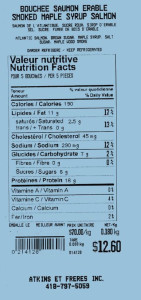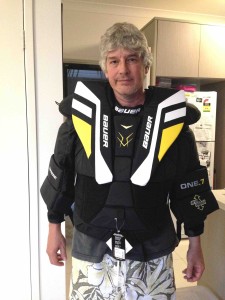I’ve long maintained that food safety gets about 1% of food discussion and food porn gets the other 99%.
This is from John Oliver’s show last Sunday and validates my assertions.
Warning, NSFV.

I’ve long maintained that food safety gets about 1% of food discussion and food porn gets the other 99%.
This is from John Oliver’s show last Sunday and validates my assertions.
Warning, NSFV.
The Otago Daily Times reports that three Dunedin Pizza Hut workers have resigned in protest after “disgusting” actions by a franchise owner who allegedly served expired food that had been thrown in a skip, extended expiry dates of chicken and seafood and refused to fix a broken mixer that leaked engine oil into dough.
 New Zealand fast-food company Restaurant Brands said it was aware of the issues and was working through them as a “matter of urgency”. The Ministry for Primary Industries is also investigating.
New Zealand fast-food company Restaurant Brands said it was aware of the issues and was working through them as a “matter of urgency”. The Ministry for Primary Industries is also investigating.
The franchise owner has denied the claims.
I have no ill-feelings to NZ and my food safety brethren, others may not.
Building on what John Oliver, then of the Daily Show, started five years ago, Damien Power writes in The New York Times there are more than 393 million civilian-owned firearms in the United States, which means there are more guns than people. If that makes you feel unsafe, visit Australia.
In Australia, it took one mass shooting in Port Arthur in 1996, where 35 people were killed, for the country to do something concrete about gun reform. The government adopted tighter gun control, banned semiautomatic weapons and started a mandatory gun buyback program.
The United States, meanwhile, has an average of nine mass shootings every 10 days, and 13,000 gun homicides a year. Gun violence is so rampant that China has warned its citizens about traveling here.
So if you’re interested in not getting shot to death and adorable koalas, Australia might be the place for you. Not being the target of snipers adds to the magic of visiting Down Under.
I’d add don’t barf and visit Aus, but food safety controls aren’t as good as gun controls.
It was a visit to the Wizard of Oz museum in Kansas that solidified my belief in the hucksters and buskers ruining the dream of America.
 I was willingly living in Kansas with a girl I fell in love with – still am — and two of my Canadian daughters were visiting in 2007, so we decided to travel down the road from Manhattan, Kansas, to Wamego, KS, home of the Wizard of Oz museum.
I was willingly living in Kansas with a girl I fell in love with – still am — and two of my Canadian daughters were visiting in 2007, so we decided to travel down the road from Manhattan, Kansas, to Wamego, KS, home of the Wizard of Oz museum.
If there’s genius in David Lynch, it’s predicting things before they happen – the elevated hairdo in Eraserhead made popular by Lyle Lovett, the Dr. Amp personified by radio-talk shrill Alan Jones.
Even John Oliver has had a go at Dr. Group, the unfortunately-named chiropractor and Kato-Kaelin–lookalike who shrills science with the veracity of a Kardashian.
Which reminds me, I gotta tell Chapman to shorten his bio.
 In academia, when starting as an assistant professor, most feel a need to put everything they farted out that passed peer review into their bio, including boy scout leader, and hockey coach.
In academia, when starting as an assistant professor, most feel a need to put everything they farted out that passed peer review into their bio, including boy scout leader, and hockey coach.
As time goes on, the bio becomes shorter, because you’ve earned that full prof title, and even you don’t give a shit about repeating everything you’ve toiled over for the past 40 years – you also correctly reason that no one else gives a shit either, and if they do, google it.
Check out the degrees behind Dr. Group.
The struggle to confirm who is legitimate and why, continues, and is often laid bare in the fanciest of university-type institutions.
 Do these people really care about learning, or are they just there, to make a paycheck, get their retirement and go through the motions.
Do these people really care about learning, or are they just there, to make a paycheck, get their retirement and go through the motions.
I won’t go into the latest details about Gwenyth preaching that livers and kidneys can be detoxed by handstands, why Canada’s Dr. Jen Gunter has taken on debunking her Gwenythness, or why a top uni in Spain scraped homeopathy — because it’s nonsense.
Instead I give you the wisdom of John Oliver.
This recall couldn’t be any more Canadian unless it somehow involved fornicating in a canoe surrounded by beavers.
John Oliver has better writers, so regarding a Canadian Senate expense audit, he said, “This scandal couldn’t be any more Canadian if public money was used to get Drake to drink maple syrup on Niagara Falls.”
 Atkins Et Frères Inc. is recalling Atkins & Frères brand Smoked Maple Syrup Salmon from the marketplace due to possible Listeria monocytogenes contamination. Consumers should not consume the recalled product.
Atkins Et Frères Inc. is recalling Atkins & Frères brand Smoked Maple Syrup Salmon from the marketplace due to possible Listeria monocytogenes contamination. Consumers should not consume the recalled product.
The recalled product has been sold at the Atkins Et Frères Inc. retail store located in Mont-Louis, Quebec.
If you think you became sick from eating or drinking a recalled product, call your doctor.
Check to see if you have recalled products in your home. Recalled products should be thrown out or returned to the store where they were purchased.
This recall was triggered by the company. The Canadian Food Inspection Agency (CFIA) is conducting a food safety investigation, which may lead to the recall of other products. If other high-risk products are recalled, the CFIA will notify the public through updated Food Recall Warnings.
The CFIA is verifying that industry is removing recalled product from the marketplace.
There have been no reported illnesses associated with the consumption of this product.
Most eat-this-don’t-eat-that studies are garbage, in the way that garbage could become a Dr. Oz endorsed superfood with a scientific study designed to generate the desired answer.
“There are so many studies being thrown around, they can seem to contradict one another,” Oliver said on his HBO show Last Week Tonight Sunday. “In just the last few months, we’ve seen studies about coffee that claim it may reverse the effects of liver damage, help prevent colon cancer, decrease the risk of endometrial cancer, and increase the risk of miscarriage.”
Take, for example, everything you’ve heard about America’s morning beverage of choice. “Coffee today is like God in the Old Testament,” he quipped. “It will either save you or kill you depending on how much you believe in its magic powers.”
The reason for all the confusing findings? According to Oliver, “Scientists are under constant pressure to publish, with tenure and funding on the line. And to get published, it helps to have results that seem new and striking. Scientists know nobody is publishing a study that says, ‘Nothing Up With Acai Berries.’ And to get those results, there are all sorts of ways that — consciously or not — you can tweak your study.”
Per usual, Oliver has an amusing solution to the problem: Scientists’ sourcing and methodology should be explained when their results are shared everywhere from viral stories to news segments. “I know what you’re thinking: ‘Hold on, if that happens, where where am I going to get all my interesting bulls— from?” says Oliver. “Don’t worry — we have you covered.’”
That’s where his idea for Todd Talks comes in. “Do you love science in all its complexity but wish it could be a little less complex and a lot less scientific?” asks an announcer. “Introducing Todd Talks, where the format of Ted Talks meets the intellectual rigor of morning news shows.”
Highlights of the hilarious talks include warnings about chocolate — “Mmm. It will kill you,” says one pseudo scientist — and some intriguing if not alarming findings on alcohol — “And in my research I found out, red wine makes babies 20 percent more sociable,” explains another.
I was just sitting here editing and writing, with some tunes on the background –the daughter went back to school after 4 weeks away, and I am surrounded by euphoric  parents every morning – when a shitty U2 song came on from that free album that no one wanted.
parents every morning – when a shitty U2 song came on from that free album that no one wanted.
U2 is a terribly overrated band, I never liked them, except for that 1991 song, Mysterious Ways, but only because it sounds like it was based on a Tom Robbins novel.
Which got me thinking about encryption, Apple, and the future of my grandsons (#2 at 10 months, left, exactly as shown).
Which quickly went to food safety information. Anything can be hacked, anything is open for public disclosure, get it out there, and if you’re any good at food safety, brag about it.
Just don’t release it free on an iPhone.
No one wanted that free U2 album.
The U.S. Food and Drug Administration reports that if you buy imported products marketed as “dietary supplements” and nonprescription drug products from ethnic or international stores, flea markets, swap meets or online, watch out. Health fraud scams  abound.
abound.
And in the U.S. too.
According to Cariny Nunez, M.P.H., a public health advisor in the Office of Minority Health at the Food and Drug Administration (FDA), health scammers often target advertising to people who prefer to shop at nontraditional places, especially those who have limited English proficiency and limited access to health care services and information.
“These scammers know that ethnic groups who may not speak or read English well, or who hold certain cultural beliefs, can be easy targets,” Nunez says. For example, Native Americans, Latinos, Asians and Africans may have a long tradition of turning to more herbal or so-called “natural” remedies. Many advertisers put the word “natural” somewhere on the package of a product, knowing it inspires trust in certain groups.
But just because a product claims to be natural doesn’t necessarily mean it’s safe, says Gary Coody, R. Ph., FDA’s national health fraud coordinator. Likewise, just because a product claims to be natural does not mean that it’s free of hidden drug ingredients.
Furthermore, these products may also be contaminated or contain potentially harmful chemicals or drug ingredients not listed on the label.
For example, many products that claim to help people lose weight contain hidden and dangerous prescription drug ingredients such as sibutramine. Sibutramine was in Meridia, a formerly FDA-approved drug that was removed from the market in October 2010 because clinical data indicated it posed an increased risk of heart problems and strokes.
Maybe all that Zamboni CO got to me when I was a kid spending hours at the hockey arena.
 I used to think I was fast enough to not worry too much about upper body padding.
I used to think I was fast enough to not worry too much about upper body padding.
I’m not fast enough anymore.
I played my first game in 10 years on Sunday, except for one in Guelph and one last year in which I let in 12 goals on what felt like 70 shots, and ripped my ACL.
We lost 3-1, but were outshot 22-10. I did OK. The team did great (I also coach this bunch of adults, and like any good coach, just want to see continuous improvement and having fun – and sweat).
In fortuitous timing, my fab partner Amy ordered me an early Xmas present which arrived today.
 This is my 20-or 30-year-old chest protector, this is my new one.
This is my 20-or 30-year-old chest protector, this is my new one.
And this is my happy face.
But public health takes place at the arena too.
The U.S. Centers for Disease Control reported last week that on December 13, 2014, the emergency management system in Lake Delton, Wisconsin, was notified when a male hockey player aged 20 years lost consciousness after participation in an indoor hockey tournament that included approximately 50 hockey players and 100 other attendees.
Elevated levels of carbon monoxide (CO) (range = 45 ppm–165 ppm) were detected by the fire department inside the arena. The emergency management system encouraged all players and attendees to seek medical evaluation for possible CO poisoning.
 The Wisconsin Department of Health Services (WDHS) conducted an epidemiologic investigation to determine what caused the exposure and to recommend preventive strategies. Investigators abstracted medical records from area emergency departments (EDs) for patients who sought care for CO exposure during December 13–14, 2014, conducted a follow-up survey of ED patients approximately 2 months after the event, and conducted informant interviews. Ninety-two persons sought ED evaluation for possible CO exposure, all of whom were tested for CO poisoning. Seventy-four (80%) patients had blood carboxyhemoglobin (COHb) levels consistent with CO poisoning (1); 32 (43%) CO poisoning cases were among hockey players. On December 15, the CO emissions from the propane-fueled ice resurfacer were demonstrated to be 4.8% of total emissions when actively resurfacing and 2.3% when idling, both above the optimal range of 0.5%–1.0% (2,3). Incomplete fuel combustion by the ice resurfacer was the most likely source of elevated CO. CO poisonings in ice arenas can be prevented through regular maintenance of ice resurfacers, installation of CO detectors, and provision of adequate ventilation.
The Wisconsin Department of Health Services (WDHS) conducted an epidemiologic investigation to determine what caused the exposure and to recommend preventive strategies. Investigators abstracted medical records from area emergency departments (EDs) for patients who sought care for CO exposure during December 13–14, 2014, conducted a follow-up survey of ED patients approximately 2 months after the event, and conducted informant interviews. Ninety-two persons sought ED evaluation for possible CO exposure, all of whom were tested for CO poisoning. Seventy-four (80%) patients had blood carboxyhemoglobin (COHb) levels consistent with CO poisoning (1); 32 (43%) CO poisoning cases were among hockey players. On December 15, the CO emissions from the propane-fueled ice resurfacer were demonstrated to be 4.8% of total emissions when actively resurfacing and 2.3% when idling, both above the optimal range of 0.5%–1.0% (2,3). Incomplete fuel combustion by the ice resurfacer was the most likely source of elevated CO. CO poisonings in ice arenas can be prevented through regular maintenance of ice resurfacers, installation of CO detectors, and provision of adequate ventilation.